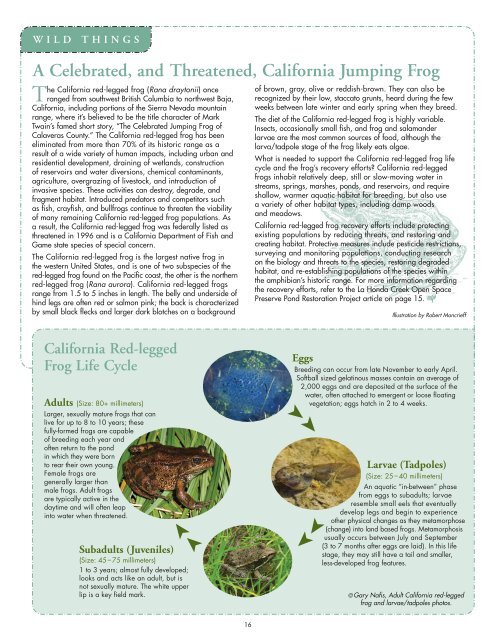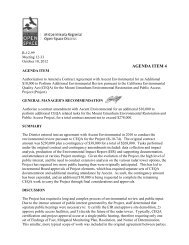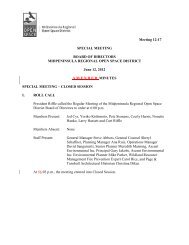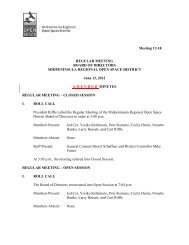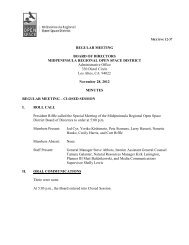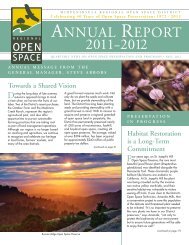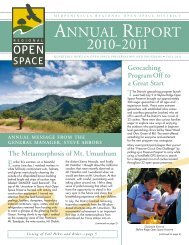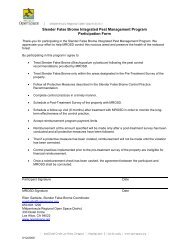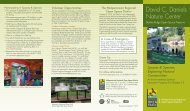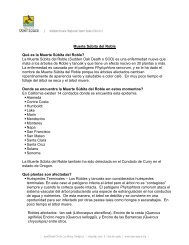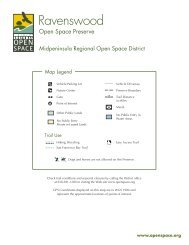Layout 1 (Page 2) - Midpeninsula Regional Open Space District
Layout 1 (Page 2) - Midpeninsula Regional Open Space District
Layout 1 (Page 2) - Midpeninsula Regional Open Space District
Create successful ePaper yourself
Turn your PDF publications into a flip-book with our unique Google optimized e-Paper software.
WILD THINGS<br />
A Celebrated, and Threatened, California Jumping Frog<br />
The California red-legged frog (Rana draytonii) once<br />
ranged from southwest British Columbia to northwest Baja,<br />
California, including portions of the Sierra Nevada mountain<br />
range, where it’s believed to be the title character of Mark<br />
Twain’s famed short story, “The Celebrated Jumping Frog of<br />
Calaveras County.” The California red-legged frog has been<br />
eliminated from more than 70% of its historic range as a<br />
result of a wide variety of human impacts, including urban and<br />
residential development, draining of wetlands, construction<br />
of reservoirs and water diversions, chemical contaminants,<br />
agriculture, overgrazing of livestock, and introduction of<br />
invasive species. These activities can destroy, degrade, and<br />
fragment habitat. Introduced predators and competitors such<br />
as fish, crayfish, and bullfrogs continue to threaten the viability<br />
of many remaining California red-legged frog populations. As<br />
a result, the California red-legged frog was federally listed as<br />
threatened in 1996 and is a California Department of Fish and<br />
Game state species of special concern.<br />
The California red-legged frog is the largest native frog in<br />
the western United States, and is one of two subspecies of the<br />
red-legged frog found on the Pacific coast, the other is the northern<br />
red-legged frog (Rana aurora). California red-legged frogs<br />
range from 1.5 to 5 inches in length. The belly and underside of<br />
hind legs are often red or salmon pink; the back is characterized<br />
by small black flecks and larger dark blotches on a background<br />
California Red-legged<br />
Frog Life Cycle<br />
Adults (Size: 80+ millimeters)<br />
Larger, sexually mature frogs that can<br />
live for up to 8 to 10 years; these<br />
fully-formed frogs are capable<br />
of breeding each year and<br />
often return to the pond<br />
in which they were born<br />
to rear their own young.<br />
Female frogs are<br />
generally larger than<br />
male frogs. Adult frogs<br />
are typically active in the<br />
daytime and will often leap<br />
into water when threatened.<br />
➤➤<br />
Subadults (Juveniles)<br />
(Size: 45 – 75 millimeters)<br />
1 to 3 years; almost fully developed;<br />
looks and acts like an adult, but is<br />
not sexually mature. The white upper<br />
lip is a key field mark.<br />
16<br />
of brown, gray, olive or reddish-brown. They can also be<br />
recognized by their low, staccato grunts, heard during the few<br />
weeks between late winter and early spring when they breed.<br />
The diet of the California red-legged frog is highly variable.<br />
Insects, occasionally small fish, and frog and salamander<br />
larvae are the most common sources of food, although the<br />
larva/tadpole stage of the frog likely eats algae.<br />
What is needed to support the California red-legged frog life<br />
cycle and the frog’s recovery efforts? California red-legged<br />
frogs inhabit relatively deep, still or slow-moving water in<br />
streams, springs, marshes, ponds, and reservoirs, and require<br />
shallow, warmer aquatic habitat for breeding, but also use<br />
a variety of other habitat types, including damp woods<br />
and meadows.<br />
California red-legged frog recovery efforts include protecting<br />
existing populations by reducing threats, and restoring and<br />
creating habitat. Protective measures include pesticide restrictions,<br />
surveying and monitoring populations, conducting research<br />
on the biology and threats to the species, restoring degraded<br />
habitat, and re-establishing populations of the species within<br />
the amphibian’s historic range. For more information regarding<br />
the recovery efforts, refer to the La Honda Creek <strong>Open</strong> <strong>Space</strong><br />
Preserve Pond Restoration Project article on page 15.<br />
Eggs<br />
Breeding can occur from late November to early April.<br />
Softball sized gelatinous masses contain an average of<br />
2,000 eggs and are deposited at the surface of the<br />
water, often attached to emergent or loose floating<br />
vegetation; eggs hatch in 2 to 4 weeks.<br />
➤➤<br />
➤➤<br />
Illustration by Robert Moncrieff<br />
Larvae (Tadpoles)<br />
(Size: 25 – 40 millimeters)<br />
An aquatic “in-between” phase<br />
from eggs to subadults; larvae<br />
resemble small eels that eventually<br />
develop legs and begin to experience<br />
other physical changes as they metamorphose<br />
(change) into land based frogs. Metamorphosis<br />
usually occurs between July and September<br />
(3 to 7 months after eggs are laid). In this life<br />
stage, they may still have a tail and smaller,<br />
less-developed frog features.<br />
© Gary Nafis, Adult California red-legged<br />
frog and larvae/tadpoles photos.


